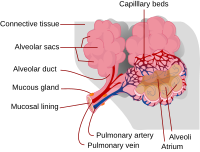
Photo from wikipedia
Background Accurate perioperative risk assessment can enhance the perioperative management of patients undergoing radical surgery for lung cancer. In this study, we compared the accuracy of predicting perioperative complications by… Click to show full abstract
Background Accurate perioperative risk assessment can enhance the perioperative management of patients undergoing radical surgery for lung cancer. In this study, we compared the accuracy of predicting perioperative complications by lung function values, estimated by blood flow ratios (BFRs), to determine whether dynamic perfusion digital radiography (DPDR) could substitute for pulmonary perfusion scintigraphy (PPS). Methods Patients scheduled for radical surgery for lung cancer who underwent simultaneous dynamic chest radiography (DCR) and lung perfusion scintigraphy were assessed. We confirmed the agreement between two methods in the assessment of the BFR and its predicted postoperative (ppo) value. Besides, the best spirometry thresholds for the risk of perioperative respiratory or cardiovascular complications were calculated from a receiver operating characteristic (ROC) analysis. The imaging methods were compared for sensitivity and specificity. Results Among the 44 cases enrolled, DPDR and PPS showed high correlations in BFR (r=0.868, P<0.01) and its postoperative value (r=0.975, P<0.01) and between the predicted and measured spirometry values. In both imaging modalities, the estimated postoperative diffusing capacity test for carbon monoxide (DLco) had the best prediction [area under the curve (AUC) >0.7] for respiratory complications within 1 month (with different cut-offs for same target cases). For predicting, respiratory complications within 1–3 months after surgery, these values were similar between two modalities. Furthermore, the ppoDLco values from both imaging methods were excellent indicators of the induction of postoperative long term oxygen therapy, with the AUC greater than 0.8. Conclusions This study showed that simple and less invasive DPDR can be a good alternative to PPS for predicting postoperative pulmonary function values and the risk of postoperative respiratory complications. This new imaging modality will offer new insights and possible functional analyses of pulmonary circulation.
Journal Title: Journal of Thoracic Disease
Year Published: 2022
Link to full text (if available)
Share on Social Media: Sign Up to like & get
recommendations!